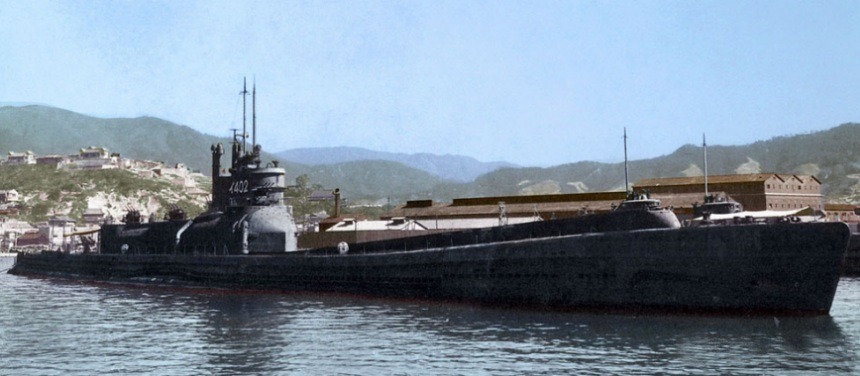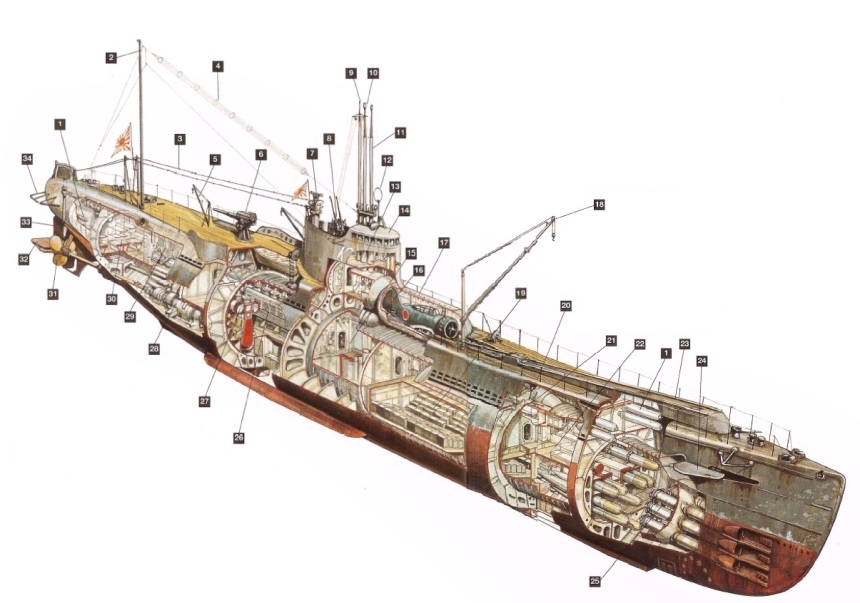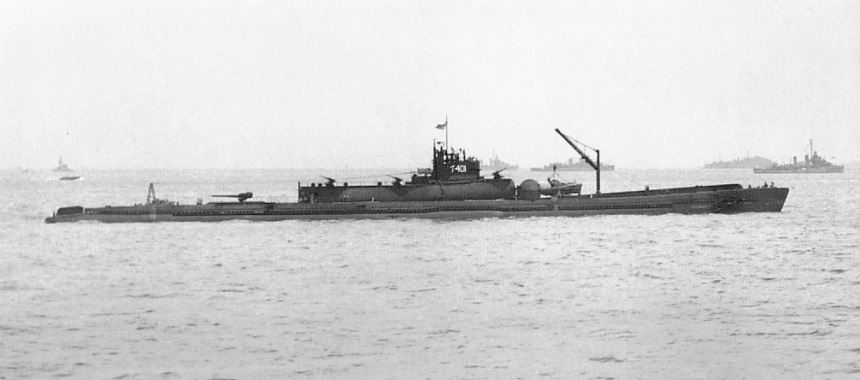Submarine aircraft carriers of Japan

The concept of an aircraft launched from a submarine is almost as old as naval aviation itself. On January 6, 1915, a modified seaplane called the «Friedrichshafen» was launched from the deck of the German submarine U-12. In the autumn of 1917, in Germany, the «Brandenburg,» which was adapted for storage directly on board a diesel-powered submarine, was tested.
Between the end of the First World War and the beginning of the Second, practically all leading maritime nations seriously considered the possibility of launching airplanes from submarines. However, in Japan, this concept underwent significant changes. This series even had the name «Sentoki.» From being just auxiliary reconnaissance tools, airplanes transformed into almost the primary weaponry of submarines. The introduction of such an aircraft for a submarine, like the «Seiran,» essentially became a part of strategic weaponry, including a bomber aircraft and an underwater aircraft carrier. The aircraft's purpose was to bomb targets that could not be reached by any conventional bomber. The main emphasis was placed on complete surprise.
The idea of a submarine aircraft carrier was conceived within the minds of the Imperial Japanese Naval Staff a few months after the start of the war in the Pacific. The plan involved constructing submarines that would surpass anything previously created, specifically designed for the transportation and launch of strike aircraft. A fleet of such submarine aircraft carriers was intended to traverse the Pacific Ocean, launching their aircraft directly before reaching their chosen targets, and then submerging. After the aerial attack, the aircraft were supposed to rendezvous with underwater carriers, and the method of crew rescue was determined based on weather conditions. Following this, the fleet would submerge once again. To enhance the psychological impact, which was considered more important than physical damage, the method of delivering the aircraft to their target was not to be revealed.
Subsequently, the submarines were supposed to either rendezvous with supply ships to receive new aircraft, bombs, and fuel or operate conventionally using torpedo weaponry. The program, naturally, evolved in an atmosphere of heightened secrecy, and it's not surprising that the Allies only learned about it after Japan's surrender. In early 1942, Japan's supreme command issued an order to shipbuilders for the largest submarines ever constructed by anyone until the dawn of the atomic age in shipbuilding. The plan was to build 18 submarine aircraft carriers. During the design process, the displacement of such submarines increased from 4,125 to 4,738 tons, and the number of aircraft on board went from three to four.
Now, the focus turned to the aircraft. The Fleet Headquarters discussed this issue with the Konishi Corporation, which had been building aircraft exclusively for the navy since the 1920s. The navy believed that the success of the entire concept depended on the aircraft's high performance. The aircraft had to combine high speed to evade interception with a long flight range of 1500 km. However, since the aircraft was essentially designed for one-time use, the chassis type wasn't even discussed. The diameter of the submarine aircraft carrier's hangar was set at 3.5 meters, but the navy insisted that the aircraft had to fit inside without any disassembly.
 Submarine I-15 (B1) type in cross-section
Submarine I-15 (B1) type in cross-section
| 1. Air tanks | 9. Signal mast | 18. Disassembled crane | 26. Machinery compartment |
| 2. Radio mast | 10,11. Periscope | 19. Battery compartment | 27. Compressor |
| 3. Shortwave antenna | 12. Ring directional antenna | 20. External hull | 28. Electric motor compartment |
| 4. Longwave antenna | 13. Navigational bridge | 21. Reinforced hull | 29. Auxiliary pneumatic generator |
| 5. Disassembled loading crane | 14. Combat bridge | 22. Torpedo compartment | 30. Crew compartment |
| 6. Deck gun | 15. Command post | 23. Catapult | 31. Propeller |
| 7. Rangefinder | 16. Folded hydroplane | 24. Horizontal stabilizer | 32. Stern horizontal stabilizer |
| 8. Anti-aircraft machine gun | 17. Hangar | 25. Torpedo tubes | 33. Vertical stabilizer |
| 34. Protective reflector |
The engineers at «Aichi» considered these demanding requirements as a challenge to their talent and accepted them without objections. As a result, on May 15, 1942, requirements for an experimental bomber «for special missions» were established. The chief designer of the aircraft was Horio Ozaki. The development of the aircraft, designated «AM-24» and abbreviated as «M6A1,» proceeded smoothly. The aircraft was designed around the «Atsuta» engine, a licensed version of the 12-cylinder liquid-cooled «Daimler-Benz» DB-601 engine.
From the very beginning, it was envisaged to use detachable floats as the only demountable part of the «Seiran» aircraft. Since the floats significantly reduced the aircraft's performance, the option of dropping them in the air if necessary was considered. Accordingly, the submarine's hangar was equipped with attachments for two floats.
In late autumn of 1944, the Imperial Navy began preparing the pilots for the «Seiran» aircraft, carefully selecting both the flight and ground personnel. On December 15th, the 631st Air Corps was established under the command of Captain Totsunoke Ariizumi. This corps was part of the 1st Submarine Fleet, which consisted of only two submarine aircraft carriers — I-400 and I-401. The fleet included 10 «Seirans.» In May, submarines I-13 and I-14 joined the fleet, participating in the training of «Seiran» crews. During six weeks of training, the time it took to launch three «Seirans» from a submarine was reduced to 30 minutes, including the installation of floats. However, in combat, it was planned to launch the planes without floats from a catapult, which required 14.5 minutes.
 The submarine I-401 at sea
The submarine I-401 at sea
The initial objective of the 1st fleet was the locks of the Panama Canal. Six aircraft were to carry torpedoes, while the remaining four were to carry bombs. Two planes were allocated for each target attack. The submarine aircraft carrier fleet was supposed to follow the same route that the Hagu-mo squadron took during the attack on Pearl Harbor three and a half years earlier. However, it soon became clear that even in the event of a successful raid, it would be utterly meaningless in terms of influencing the strategic situation in the war.
As a result, on June 25th, an order was issued to send the 10th submarine fleet to attack American aircraft carriers at Ulithi Atoll. On August 6th, I-400 and I-401 left Ominato, but shortly after departure, a fire broke out on the flagship due to a short circuit. This forced a delay in the operation until August 17th, just two days before Japan surrendered. However, even after surrender, the Japanese fleet headquarters planned to carry out the attack on August 25th. Nevertheless, on August 16th, the fleet received orders to return to Japan, and four days later, to destroy all offensive weapons. The commander of the flagship submarine aircraft carrier I-401, Captain Totsunoke Ariizumi, committed suicide, and the crew launched the pilotless planes and did not start the engines. On I-400, it was simpler: both planes and torpedoes were simply pushed into the water.
And so, the suicidal operation came to an end, involving kamikaze pilots and state-of-the-art torpedo bombers based on the world's largest submarines. Even in this case, alongside the use of the most advanced and modern weaponry, Japanese engineering and military thinking could not do without the assistance of kamikaze. All of this once again attests to the adventurism of the highest military leadership, fixated on the use of suicide attackers, relying on the «Japanese spirit,» and developing the most incredible weapon systems in the hope of a miracle.
All «submarine aircraft carriers» were delivered for examination to the US Navy base at Pearl Harbor (Hawaii), but as early as May 1946, they were taken out to sea, fired upon with torpedoes, and sunk due to the demand of the Soviet Union for access to them.
In March 2005, a underwater expedition from the University of Hawaii discovered the sunken Japanese submarine «I-401» on the floor of the Pacific Ocean near the Hawaiian island of Oahu. John Wiltshire, the Acting Director of the Underwater Research Laboratory at the University of Hawaii, reported that the remains of the «I-401» submarine, which had broken into two parts, were found at a depth of 820 meters and visually examined using a remotely operated underwater vehicle.
Technical specifications «Sentoku» class submarine aircraft carrier (I-400):
- Displacement — 6 550 tons
- Length — 120 m
- Beam — 12 m
- Range — 3 500 nmi
- Depth — 100 m
- Propulsion — diesel engines
- Speed — 18 knots
- Complement — 144
- 1 * 140 mm gun
- 3 * 25 mm gun
- 8 * torpedo tubes
- 3 * aircraft.
- Comments
 en
en ru
ru uk
uk




